Changes and Continuities of Gender Roles in India
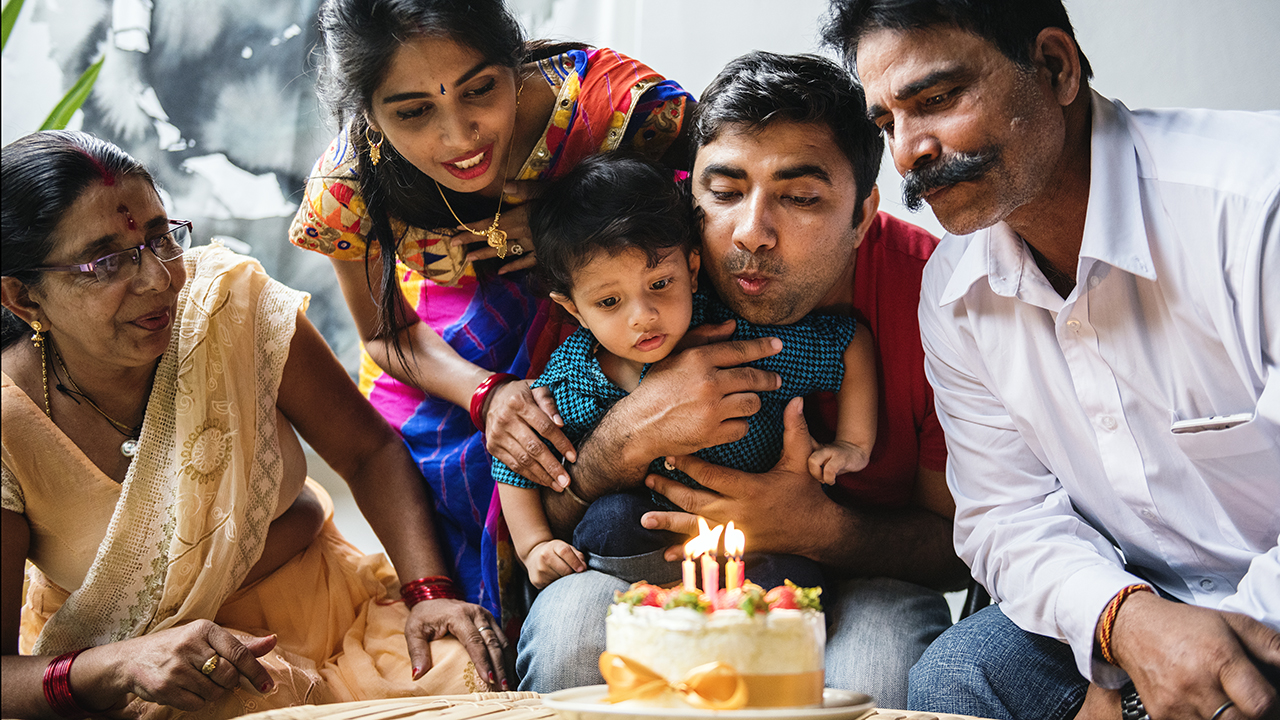
This study is part of Pew Research Center's most comprehensive, in-depth exploration of India to date. For this report, we surveyed 29,999 Indian adults (including 22,975 Hindus, 3,336 Muslims, 1,782 Sikhs, 1,011 Christians, 719 Buddhists, 109 Jains and 67 respondents who belong to another religion or are religiously unaffiliated). Many findings from the survey in India were previously published in "Religion in India: Tolerance and Segregation," which looked in detail at religious and national identity, religious beliefs and practices, and attitudes among religious communities. The survey also included several questions on gender roles in Indian society, but these questions were not analyzed in the previous report and are now being published for the first time. Interviews for this nationally representative survey were conducted face-to-face under the direction of RTI International from Nov. 17, 2019, to March 23, 2020.
To improve respondent comprehension of survey questions and to ensure all questions were culturally appropriate, the Center followed a multiphase questionnaire development process that included expert review, focus groups, cognitive interviews, a pretest and a regional pilot survey before the national survey. The questionnaire was developed in English and translated into 16 languages, independently verified by professional linguists with native proficiency in regional dialects.
Respondents were selected using a probability-based sample design that would allow for robust analysis of all major religious groups in India – Hindus, Muslims, Christians, Sikhs, Buddhists and Jains – as well as all major regional zones. Data was weighted to account for the different probabilities of selection among respondents, and to align with demographic benchmarks for the Indian adult population from the 2011 census. The survey is calculated to have covered 98% of Indians ages 18 and older and had an 86% national response rate.
For more information, see the Methodology for this report. The questions used in this analysis can be found here.
More than half a century ago, India was one of the first countries in the world to elect a woman as prime minister, and the country currently has several highly influential women politicians, including Sonia Gandhi, the head of one of the major national parties. Today, most Indians say that "women and men make equally good political leaders," and more than one-in-ten feel that women generally make better political leaders than men, according to a recent Pew Research Center survey of nearly 30,000 adults throughout India. Only a quarter of Indian adults take the position that men make better political leaders than women.
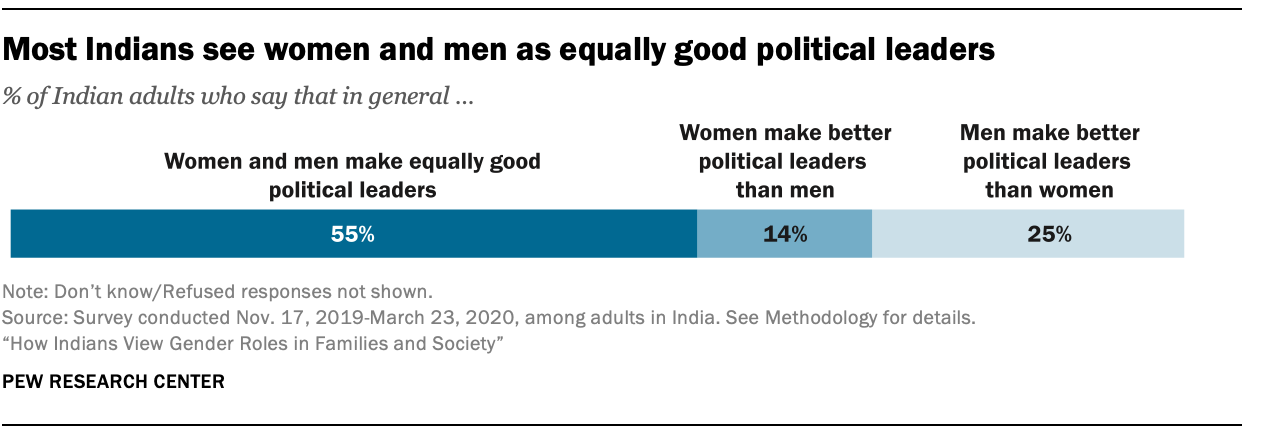
Yet, in domestic settings, Indians tend to say men should have more prominent roles than women. About nine-in-ten Indians agree with the notion that a wife must always obey her husband, including nearly two-thirds who completely agree with this sentiment. Indian women are only slightly less likely than Indian men to say they completely agree that wives should always obey their husbands (61% vs. 67%), according to the survey, which was conducted between late 2019 and early 2020 (mostly before the COVID-19 pandemic).
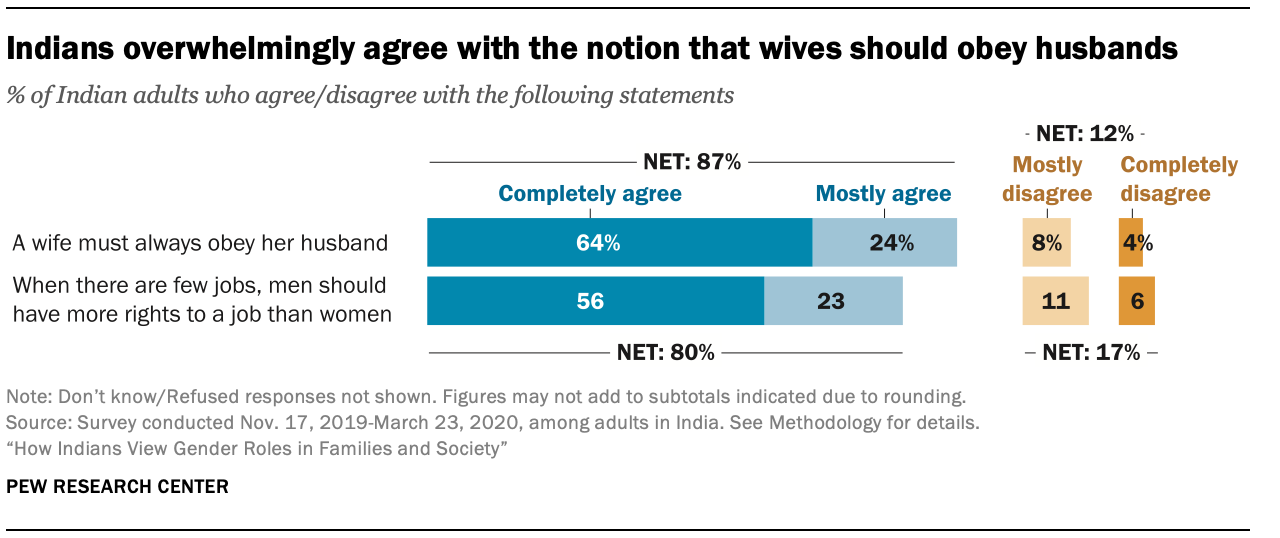
Many Indians express egalitarian views toward some gender roles in the home. For instance, 62% of adults say both men and women should be responsible for taking care of children. But traditional gender norms still hold sway among large segments of the population: Roughly a third of adults (34%) feel that child care should be handled primarily by women.
Similarly, a slim majority (54%) says that both men and women in families should be responsible for earning money, but many Indians (43%) see this as mainly the obligation of men. And Indian adults overwhelmingly say that when jobs are in short supply, men should have greater rights to employment than women, reflecting the continued prominence of men in the economic sphere. Eight-in-ten agree with this sentiment, including a majority (56%) who completely agree.
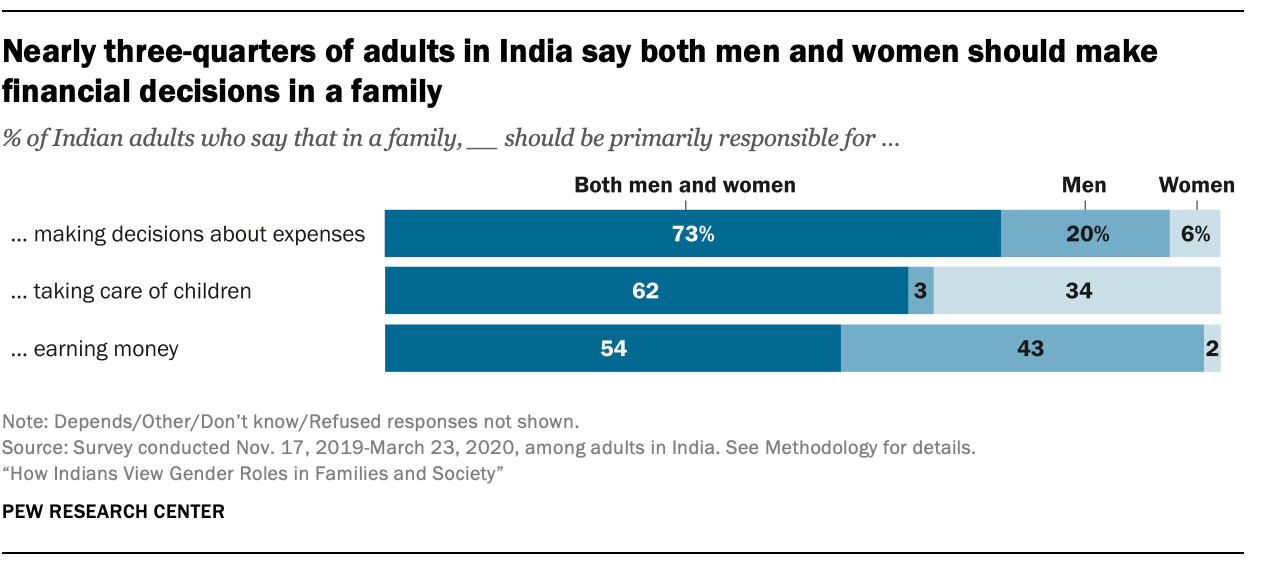
Indians value having both sons and daughters: Nearly all Indians say it is very important for a family to have at least one son (94%) and, separately, to have at least one daughter (90%). And most Indians say that both sons and daughters should have equal rights to inheritance from parents (64%) and have the responsibility to care for parents as they age (58%). But survey respondents are far more likely to say that sons, rather than daughters, should have greater rights and responsibilities in these areas. For example, while about four-in-ten Indian adults say that sons should have the primary responsibility to care for aging parents, just 2% say the same about daughters.
Moreover, most Indians (63%) see sons – not daughters – as being primarily responsible for parents' last rites and burial rituals. Religious funeral practices for loved ones are widely seen as very important, and at least according to Hindu tradition, sons must perform last rites for a parent to ensure freedom for the soul in the afterlife. Recently, women – including actress Mandira Bedi and the daughters of India's former Chief of Defense Staff – have publicly challenged these norms by lighting family members' funeral pyres.
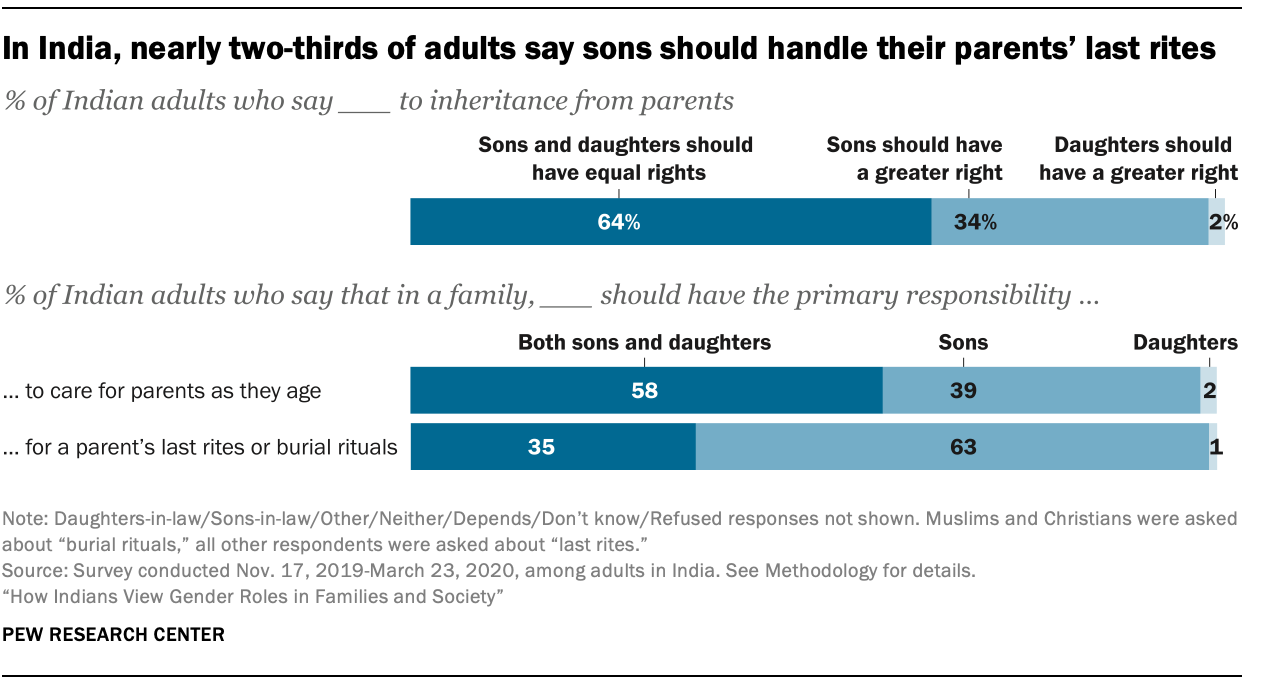
These norms are part of a wider phenomenon in Indian society where, for a variety of historical, social, religious and economic reasons, families tend to place higher value on sons rather than daughters – a custom broadly referred to as "son preference." Adult sons traditionally live with their parents and provide financial support to the family. Meanwhile, when daughters marry, their families may pay a dowry, an illegal practice that still features in some marriages, and daughters often live with their husband's parents and fulfill obligations toward their in-laws. In recent years, Indian society has paid increased attention to improving the status of daughters – the government's Beti Bachao, Beti Padhao ("Save the girl child, Educate the girl child") program, for example, seeks to prevent sex-selective practices during pregnancy and to ensure educational opportunities for girls by conducting public awareness media campaigns, among other policies.
Son preference and the increased availability of ultrasounds in recent decades have contributed to the selective abortion of female fetuses across India, despite the illegality of the practice. And for many years, India has had one of the most skewed sex ratios at birth in the world. For example, according to the 2011 census, there were 111 boys born for every 100 girls born in India, though recent data suggests the gap may be narrowing.1
Many Indians see sex-selective abortion as acceptable in at least some circumstances: Four-in-ten Indians say it is either "completely acceptable" or "somewhat acceptable" to "get a checkup using modern methods to balance the number of girls and boys in the family," a euphemism to connote sex-selective abortion.2 A similar share (42%) says balancing the number of girls and boys in a family via modern methods is completely unacceptable, while roughly one-in-ten describe the practice as "somewhat" unacceptable.
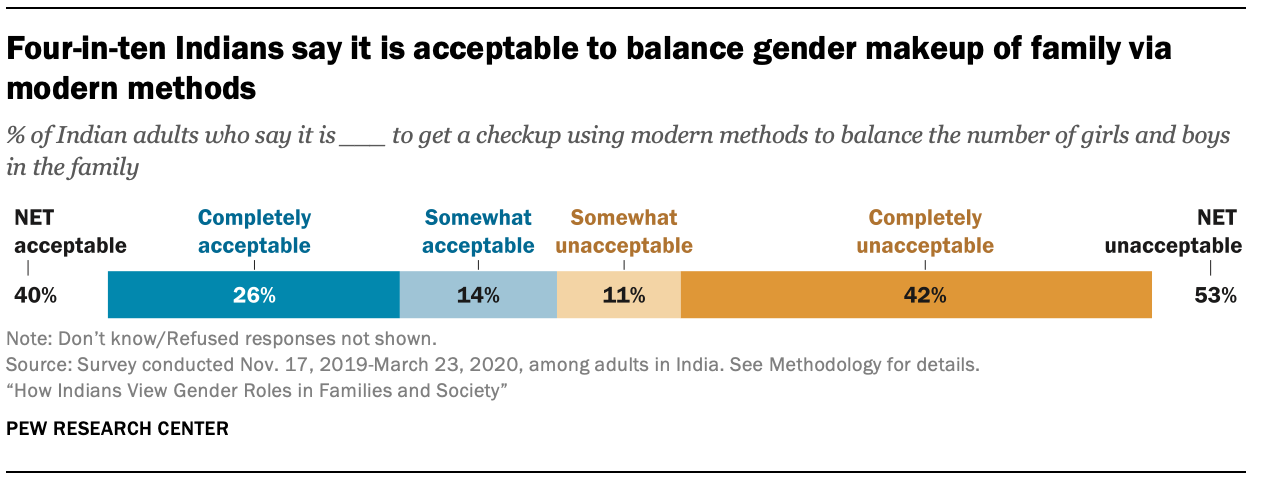
On this question and all others included in this report, differences in opinion between men and women and across age groups are modest. In other words, Indian women typically are not much more likely than Indian men to express egalitarian views on son preference and gender roles (see "In India, men a little more likely than women to have conservative views on gender"), and the same is true of young Indian adults (ages 18 to 34) relative to their elders.
This is the second report based on a Pew Research Center survey conducted face-to-face nationally among 29,999 Indian adults. Many findings from the survey were previously published in "Religion in India: Tolerance and Segregation," which looked in detail at religious and national identity, religious beliefs and practices, and attitudes among religious communities. The survey also included several questions on gender roles in Indian society, but these questions were not analyzed in the previous report and are now being published for the first time. (Another recent Pew Research Center report, "Religious Composition of India," used Indian census data to examine how India's religious makeup has changed since independence.)
Local interviewers administered the survey between Nov. 17, 2019, and March 23, 2020, in 17 languages. The survey covered all states and union territories of India, with the exceptions of Manipur and Sikkim – where the rapidly-developing COVID-19 situation prevented fieldwork from starting in the spring of 2020 – and the remote territories of the Andaman & Nicobar Islands and Lakshadweep; these areas are home to about a quarter of 1% of the Indian population. The union territory of Jammu and Kashmir was covered by the survey, though no fieldwork was conducted in the Kashmir region itself due to security concerns.
This study, funded by The Pew Charitable Trusts and the John Templeton Foundation, is part of a larger effort by Pew Research Center to understand religious change and its impact on societies around the world. The Center previously has conducted religion-focused surveys across sub-Saharan Africa; the Middle East-North Africa region and many other countries with large Muslim populations; Latin America; Israel; Central and Eastern Europe; Western Europe; and the United States.
The rest of this Overview covers perceptions of gender discrimination; how Indian attitudes on gender compare globally; the strong influence of education and religion in gender attitudes; the minimal differences in gender attitudes between Indian men and women, and among adults of different ages; and regional and state-level variation in how gender roles are viewed.
Indians perceive more discrimination against women than religious minorities, but most say women do not face 'a lot of discrimination'
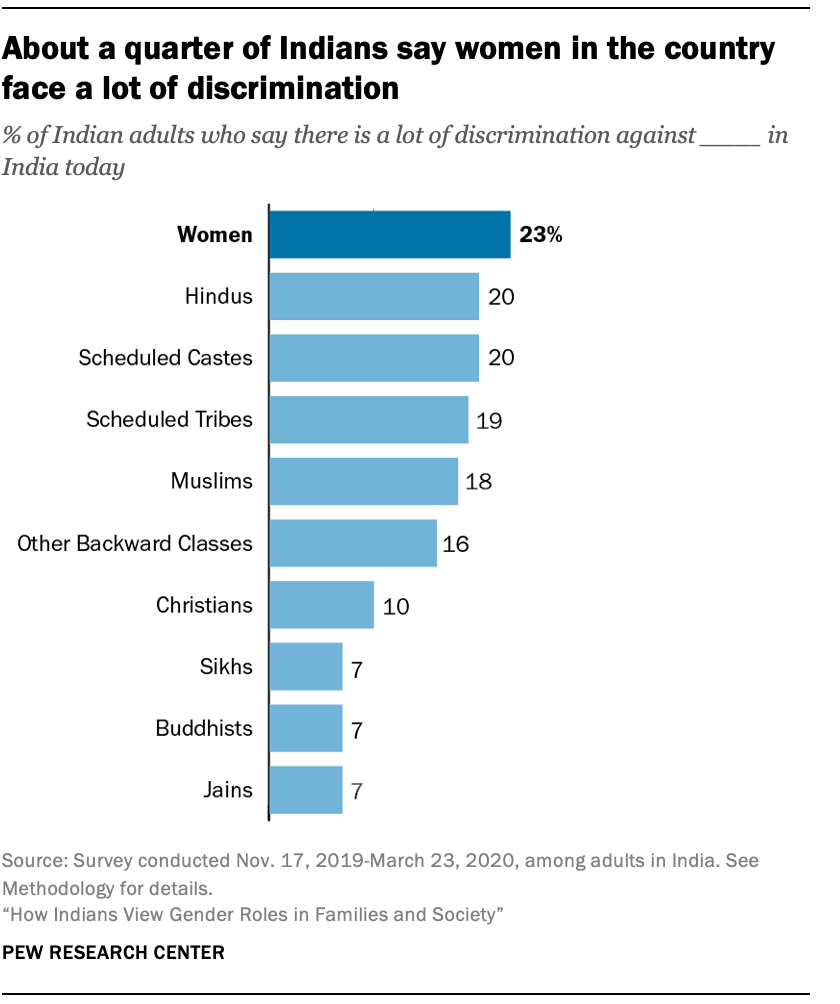 Almost a quarter of Indians (23%) say there is "a lot of discrimination" against women in their country, slightly more than the shares who say some religious groups or lower castes face a lot of discrimination. This means that the vast majority of Indian adults do not see a lot of discrimination against any of these groups.
Almost a quarter of Indians (23%) say there is "a lot of discrimination" against women in their country, slightly more than the shares who say some religious groups or lower castes face a lot of discrimination. This means that the vast majority of Indian adults do not see a lot of discrimination against any of these groups.
About one-in-six Indian women (16%) said that they had personally felt discriminated against because they are a woman in the last 12 months before the 2019-2020 survey – comparable to the shares of women who said they have recently felt discriminated against due to their religion (16%) or their caste (14%). Similar shares of Indian men said they had faced recent gender (14%), religious (17%) or caste (15%) discrimination.
But far more adults see violence against women as a major national issue. As described in a previous Pew Research Center report, three-quarters of Indians say violence against women is a "very big problem" – greater than the share who say communal violence is a very big problem (65%), and similar to the shares who say this about crime and corruption (76% each). Police cases registered as "crimes against women" nearly doubled between 2010 and 2019, and rapes and murders of women have led to massive protests across India.
The survey asked respondents which of two options is more important to improve the safety of women in their community: teaching boys to respect all women or teaching girls to behave appropriately. Roughly half of Indians say teaching boys to respect women is more important, while about a quarter of Indians say teaching girls to behave appropriately is the better way to improve women's safety. An additional quarter of Indian adults don't take a clear position between those two options, instead voicing that some combination of the two approaches is necessary, that improved law and order through policing will improve the situation or that women are already safe. Women are slightly more likely than men to say that teaching boys to respect all women is the more important way to improve safety (53% vs. 48%).
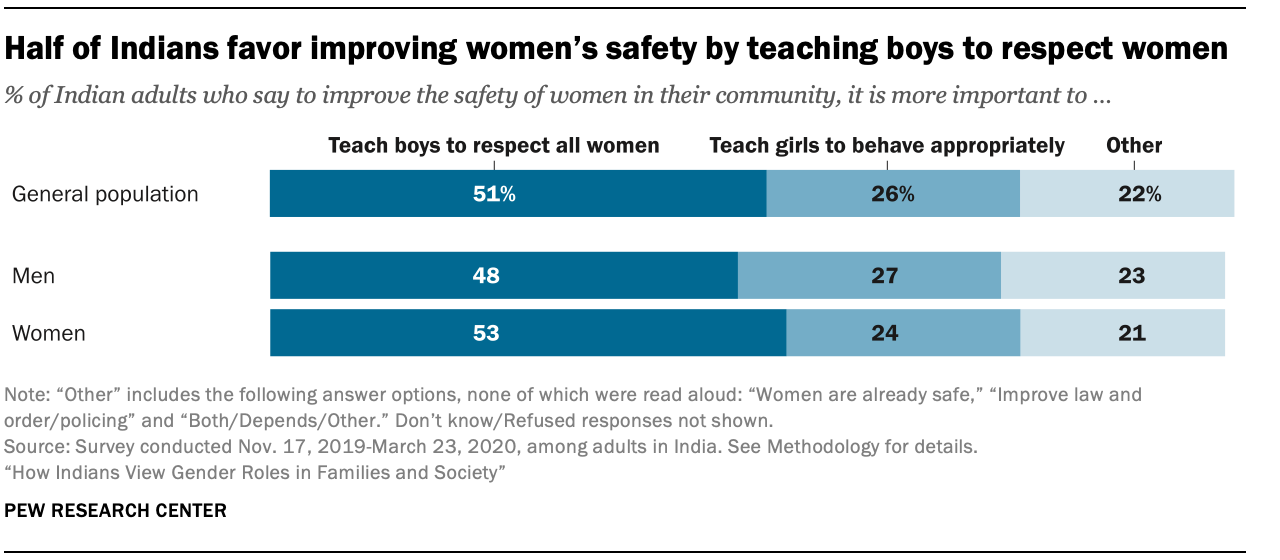
How India's gender attitudes compare globally
Pew Research Center has asked a couple of the questions on this survey in many countries around the world, allowing a glimpse of where Indians fit globally when it comes to public opinion on these issues.
Across 47 countries and territories, a global median of 70% say it is very important for women to have the same rights as men, according to data from two recent waves of the Center's Global Attitudes survey. This is similar to the share of Indians who feel gender equality is very important (72%).3
Indians are less likely than people in North America (92% median), Western Europe (90%) and Latin America (82%) to place high importance on women and men having the same rights. But they are more likely than those living in sub-Saharan Africa (48% median) and the Middle East-North Africa region (44%) to say this. Adults in Central and Eastern Europe (69% median) are roughly similar to Indians on this question.
Within South Asia, Indians are somewhat more likely than Pakistanis to say it is very important for men and women to have equal rights (72% vs. 64%).
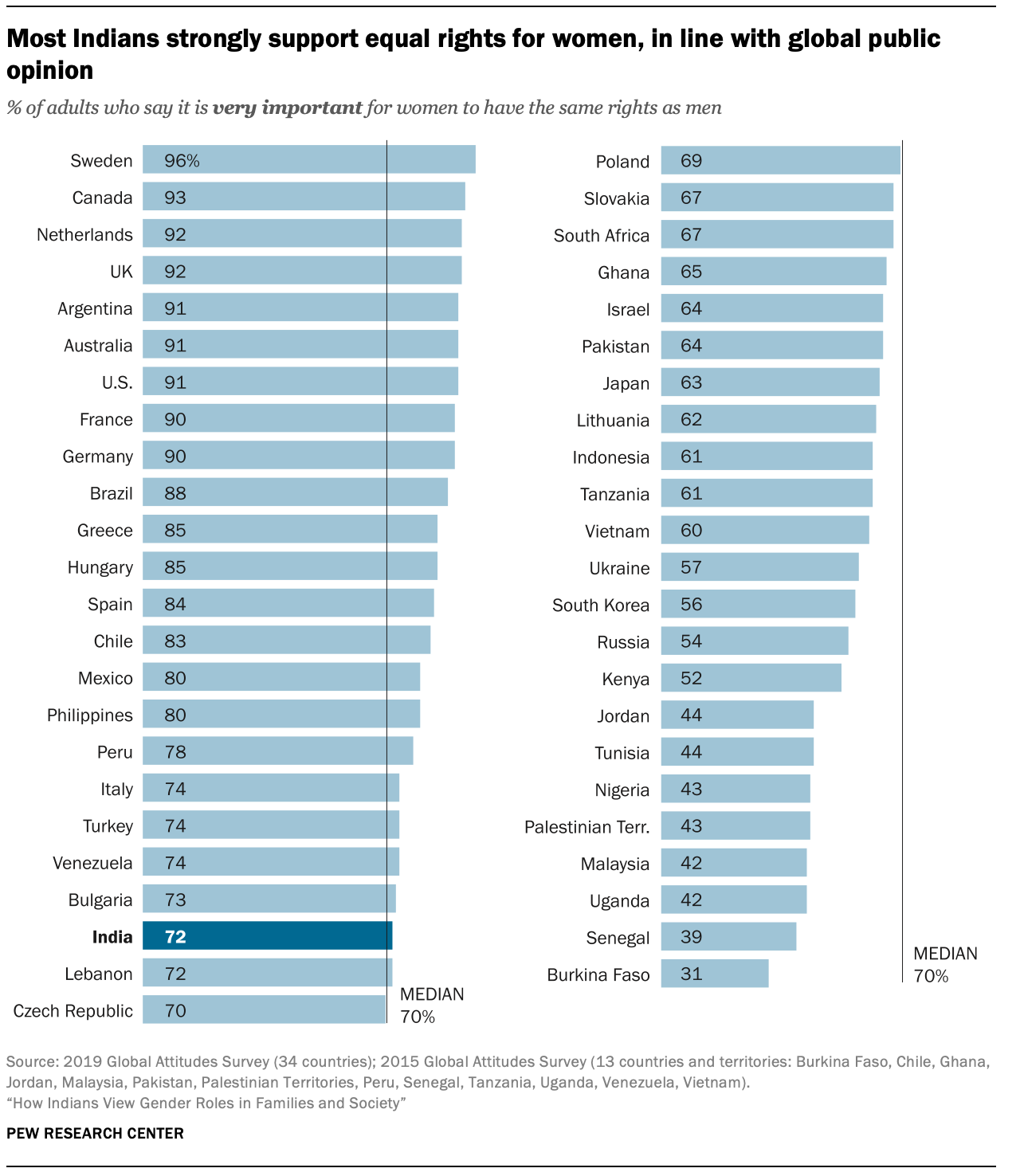
Despite broadly aligning with global public opinion on equal rights for women, Indians tend to be more conservative than people in most other countries surveyed when it comes to gender dynamics in the home and in the economy.
For instance, across 61 countries surveyed from 2013 to 2019, a median of 17% completely agree with the statement "When jobs are scarce, men should have more rights to a job than women," but roughly three times as many Indians say the same (55%).4 In fact, only one surveyed country – Tunisia (64%) – has a higher share who completely agree with the notion that men should have greater rights to jobs in times of high unemployment.
On this measure, Indians are substantially more traditional than people from North America (4% median), Western Europe (7%), Central and Eastern Europe (14%) and Latin America (20%).
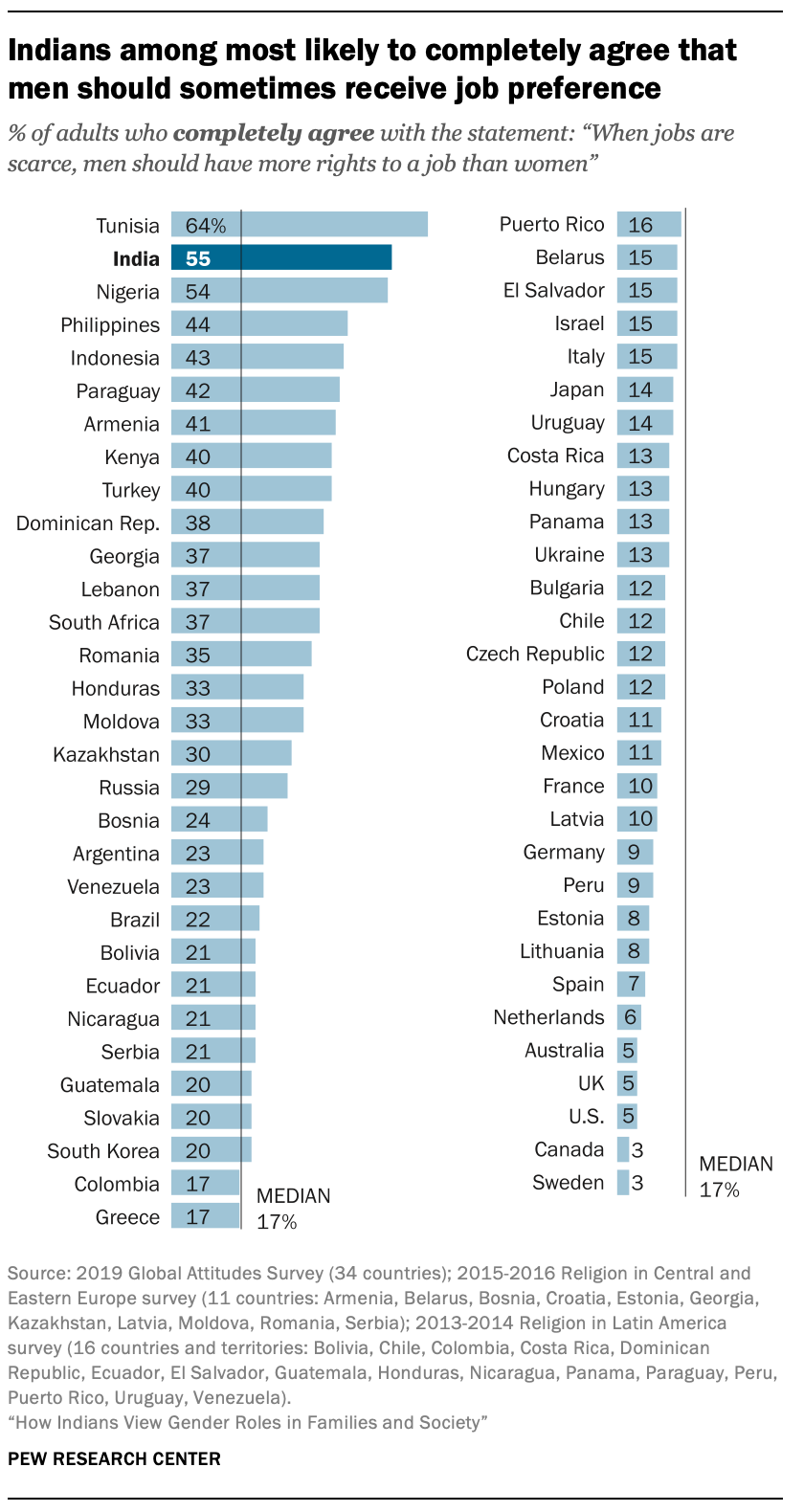
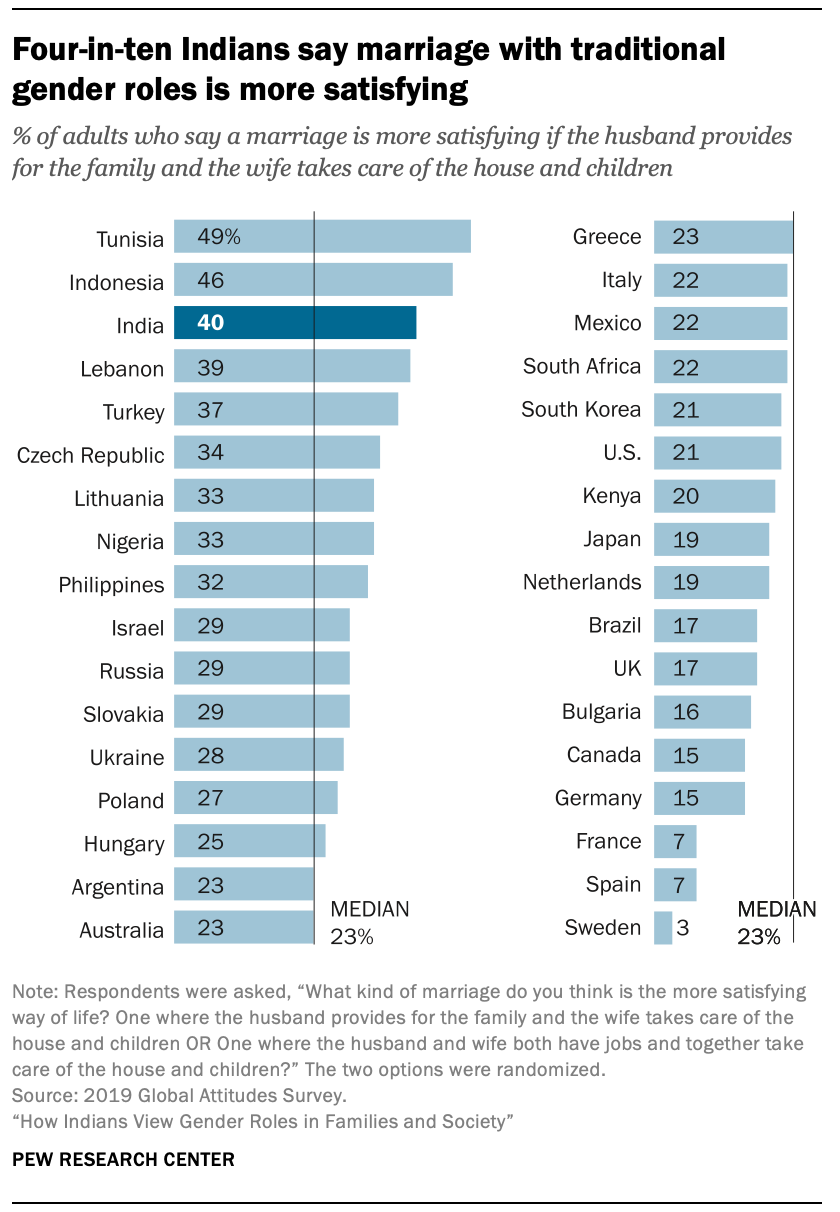 These attitudes, combined with a scarcity of jobs, may be one reason why India has one of the lowest female labor force participation rates in the world (21% vs. 53% global median), according to 2019 United Nations (UN) data. India's male labor force participation rate is much higher (76%), and this within-country discrepancy contributes to India's low ranking on the UN Gender Inequality Index (123rd out of 162 ranked countries).
These attitudes, combined with a scarcity of jobs, may be one reason why India has one of the lowest female labor force participation rates in the world (21% vs. 53% global median), according to 2019 United Nations (UN) data. India's male labor force participation rate is much higher (76%), and this within-country discrepancy contributes to India's low ranking on the UN Gender Inequality Index (123rd out of 162 ranked countries).
The 2019 Global Attitudes survey in 34 countries also asked a question about gender roles that was not on the 2019-2020 India survey: "Which kind of marriage is more satisfying, one where the husband provides for the family and the wife takes care of the house and children, or one where the husband and wife both have jobs and together take care of the house and children?"
Indians are among the most likely to say the husband should provide for the family while the wife focuses on the home: Four-in-ten Indians prefer this traditional family dynamic, compared with a global median of 23%.
Indians with a college degree are less likely to hold traditional views on gender roles
Indian adults with a college degree are less likely than those without a college education to support conservative gender norms. For example, about a quarter of college-educated Indians (24%) say women in a family should be primarily responsible for taking care of children, while roughly a third of Indians with less formal education (35%) say child care responsibility should rest with women.
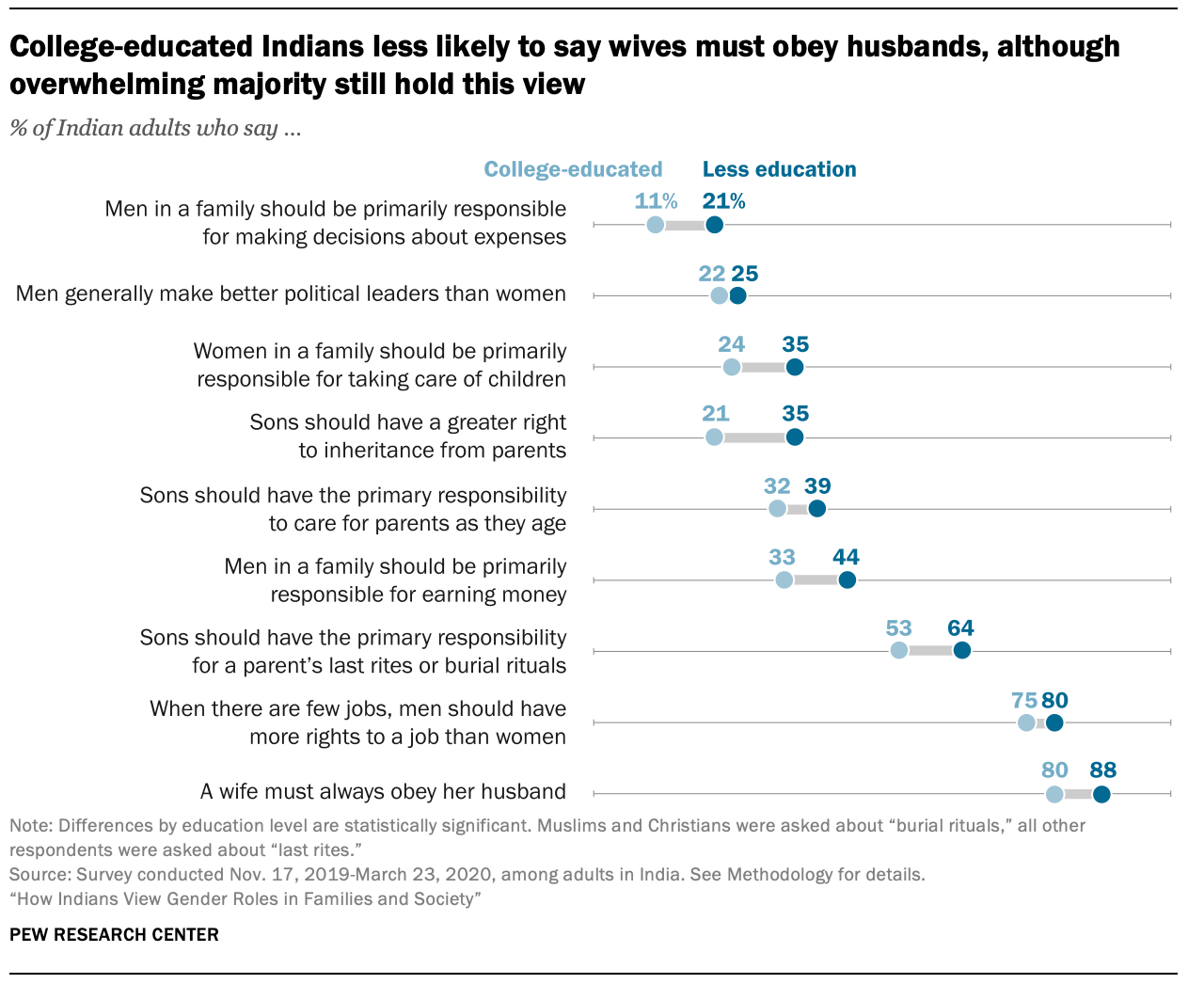
However, even Indians who have completed college sometimes do overwhelmingly endorse traditional views on gender-related issues. For instance, large majorities among those with a college degree (80%) and those with less education (88%) agree with the notion that wives must always obey their husbands.
Muslims more likely than other Indians to say men should provide a family's income
India's main religious groups have widely divergent opinions about gender roles in the family. For example, while nearly three-quarters of Indian Muslims (74%) say that sons should have the primary responsibility for a parent's burial rituals, just 29% of Sikhs say that sons alone should handle last rites. Across several aspects of family life, this pattern repeats: Muslims are the most likely, and Sikhs are the least likely, to support traditional gender roles.
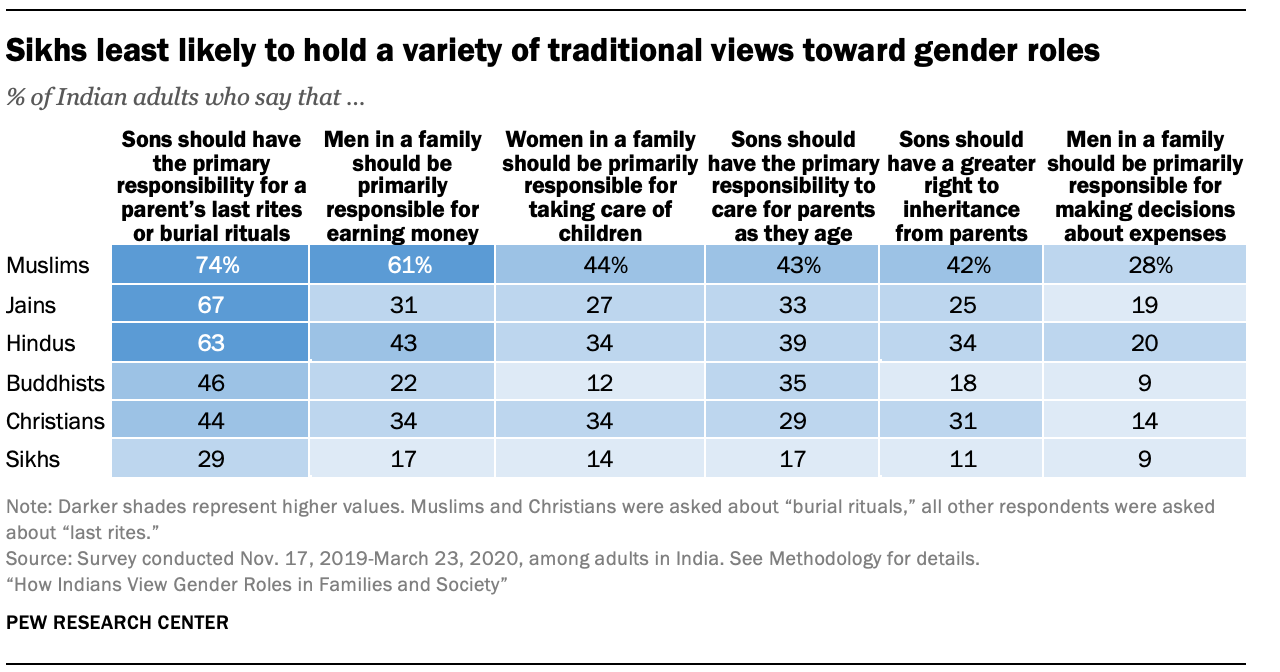
Muslims are somewhat less likely than Sikhs to have a college education (5% vs. 9%), based on the 2011 census, and as noted previously, Indians without a college degree are more likely to hold conservative gender attitudes. But even when considering education, Muslims are far more likely than Sikhs to support traditional gender roles in the family. For instance, about a third of college-educated Muslims (32%) say women should be primarily responsible for taking care of children, while only about one-in-ten college-educated Sikhs (9%) share this view.
The overwhelming majority of India's Sikh community lives in the state of Punjab (India's only majority-Sikh state), and people in Punjab consistently express less preference for traditional gender roles within the home – a pattern that is not just driven by Sikhs in the state. Indeed, Punjabi Hindus are much less likely than Hindus nationally to express traditional views on some gender roles. For example, while 34% of Indian Hindus overall say women should be primarily responsible for taking care of children, just 13% of Punjabi Hindus say this – similar to the 14% of Indian Sikhs who take this position. (See "Southern states not necessarily more egalitarian than Hindi Belt states in gender attitudes" for more on state and regional differences across India.)
For many years, Punjab has had one of the most skewed sex ratios across Indian states. According to the 2011 census, for every 119 boys born in Punjab, 100 girls were born. However, more recent data suggests the skew may be decreasing. In the most recently conducted National Family Health Survey (NFHS), there were 111 boys born in Punjab for every 100 girls. 5
In India, men a little more likely than women to have conservative views on gender
Across a variety of measures, Indian men are more likely than women – but only slightly – to take a traditional view of gender roles. For instance, 82% of men say that when there are few jobs, men should have more rights to jobs, compared with 77% of women who share this perspective.
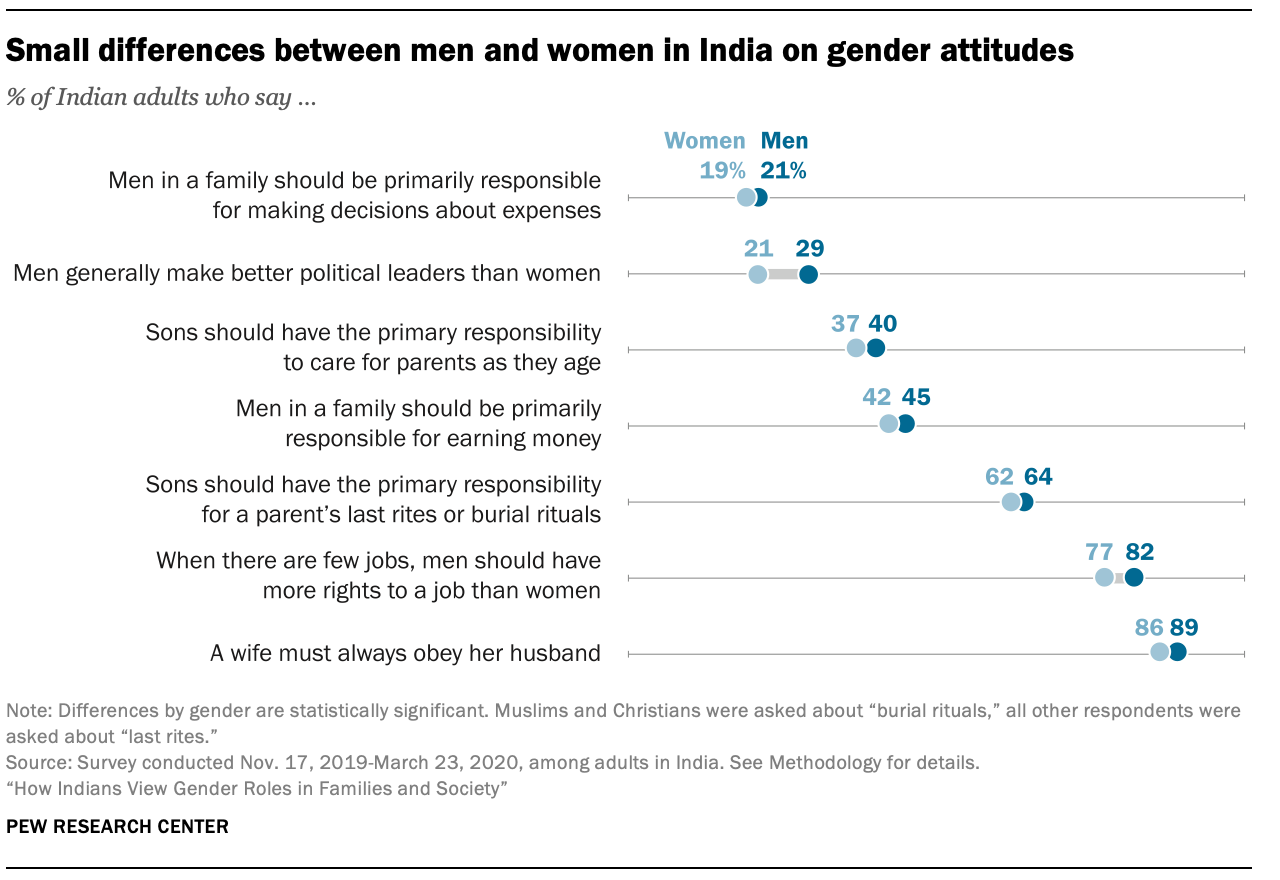
Similarly, older Indians (ages 35 and older) are marginally more likely than younger adults to hold traditional views on gender roles. While 45% of Indians ages 35 and older say that men in a family should be primarily responsible for earning money, 42% of those ages 18 to 34 agree.
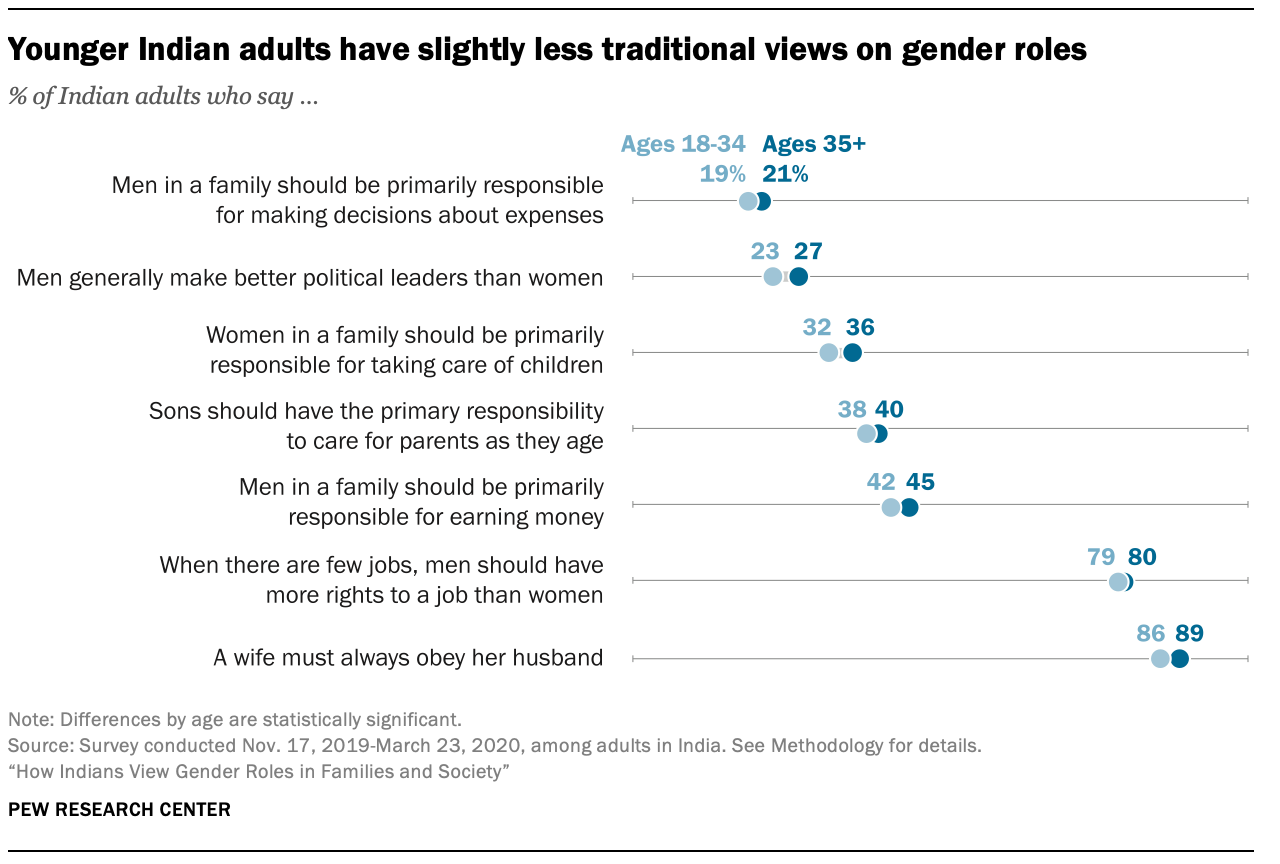
Even when looking at attitudes only among Indian women, the differences between younger and older adults are minimal, with older women slightly more likely than younger women (ages 18 to 34) to hold conservative views on gender roles. For example, 37% of older Indian women (ages 35 and older) think women in a family should be primarily responsible for caring for children, while a third of younger Indian women take this position.
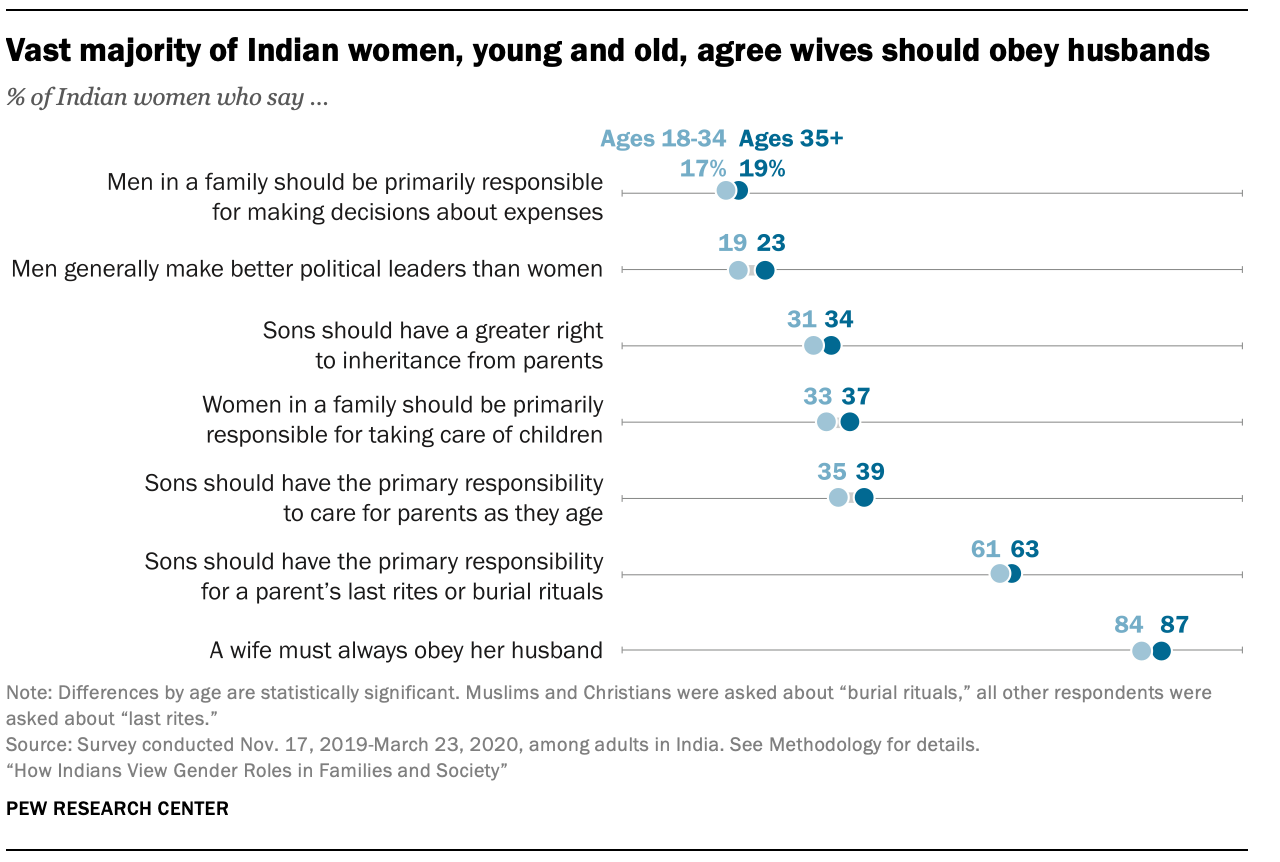
Sidebar: India's changing gender norms
The general consistency across age groups could suggest that Indian attitudes on family gender roles may not be changing very much over time. But a long-running survey shows that attitudes and behaviors on gender roles appear to have become more egalitarian since the end of the 20th century, with perhaps the biggest changes in the early 2000s.
India's National Family Health Survey (NFHS) has been conducted five times, with the first happening roughly three decades ago. Typically, women ages 15 to 49 and men ages 15 to 54 in selected households are eligible to be interviewed.6 By comparison, all Indian adults (ages 18 and older) were eligible to be included in the Pew Research Center survey. Differences in sampling and question wording make it difficult to compare the two surveys directly. Still, NFHS surveys are useful in analyzing data over time.
Between the survey's second (1998-99) and third (2005-06) rounds of data collection, several measures showed a move away from traditional attitudes. For example, while 31% of married women under age 50 who were earning money in 1998 and 1999 said that their husband was mainly deciding how to use the money the wife earned, that number halved (15%) by 2005 and 2006.
Between the survey's third (2005-06) and fourth (2015-16) rounds, changes have been more modest, though still with a slight tendency toward less conservative views. Over that decade, for instance, the share of married men under age 50 who said husbands should have the greater say in deciding about visits to a wife's family or relatives declined slightly, from 26% to 21%.7 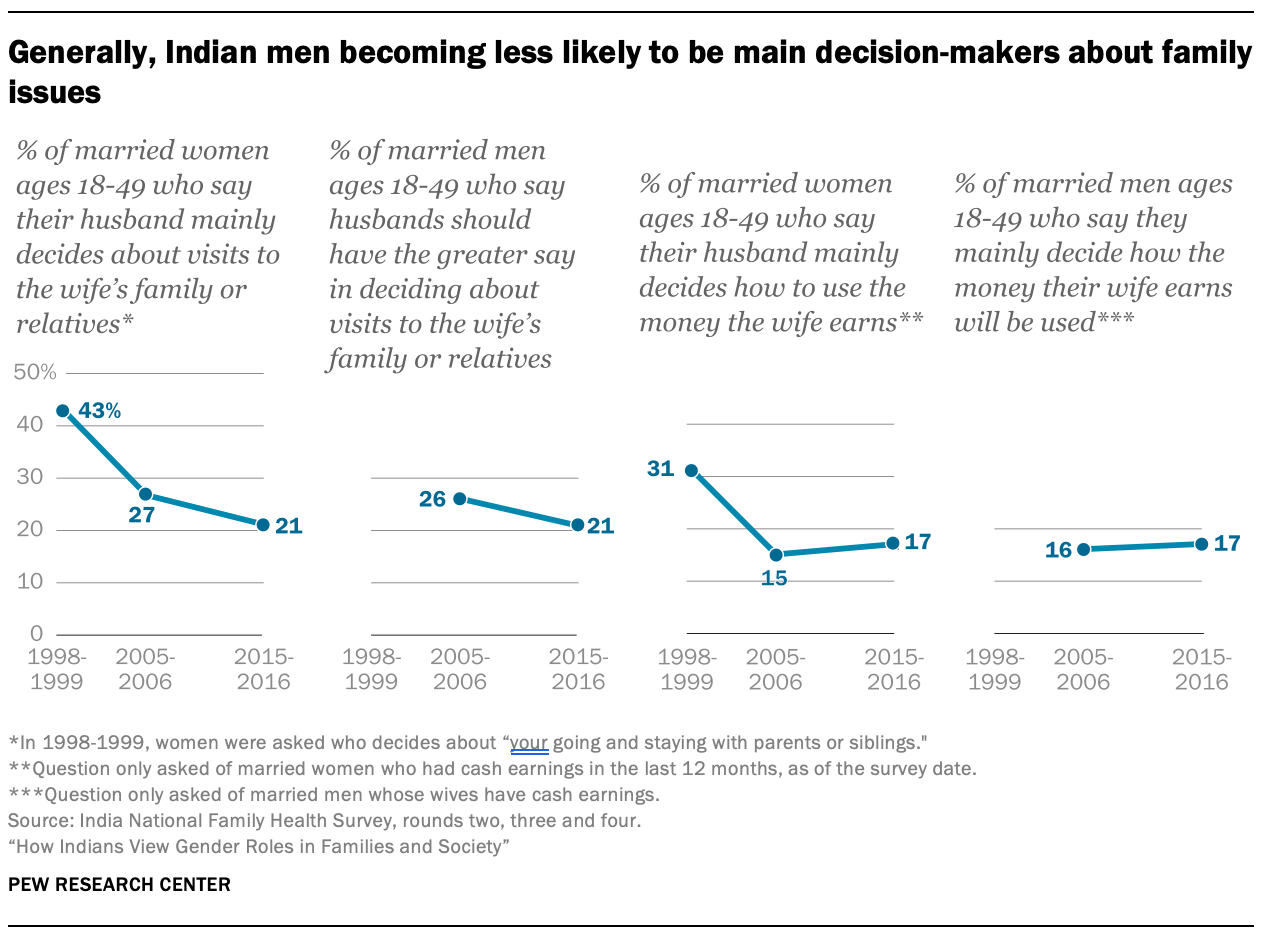
Southern states not necessarily more egalitarian than Hindi Belt states in gender attitudes
Women in India's Southern states generally have better socioeconomic outcomes, on average, than those in other parts of the country, particularly when compared with states in the Northern Hindi Belt. For instance, Southern women tend to be more highly educated and to live longer. This North-South divide is commonly discussed in academic literature.
But Southern attitudes toward gender roles are not necessarily more egalitarian. While Indians in the South are less likely than those in the Hindi Belt to say, for example, that a wife must always obey her husband (75% vs. 94%), Southern adults are more likely to say that men in families should be responsible for making decisions about expenses (25% vs. 13%) and that women should be primarily responsible for taking care of children (44% vs. 30%).
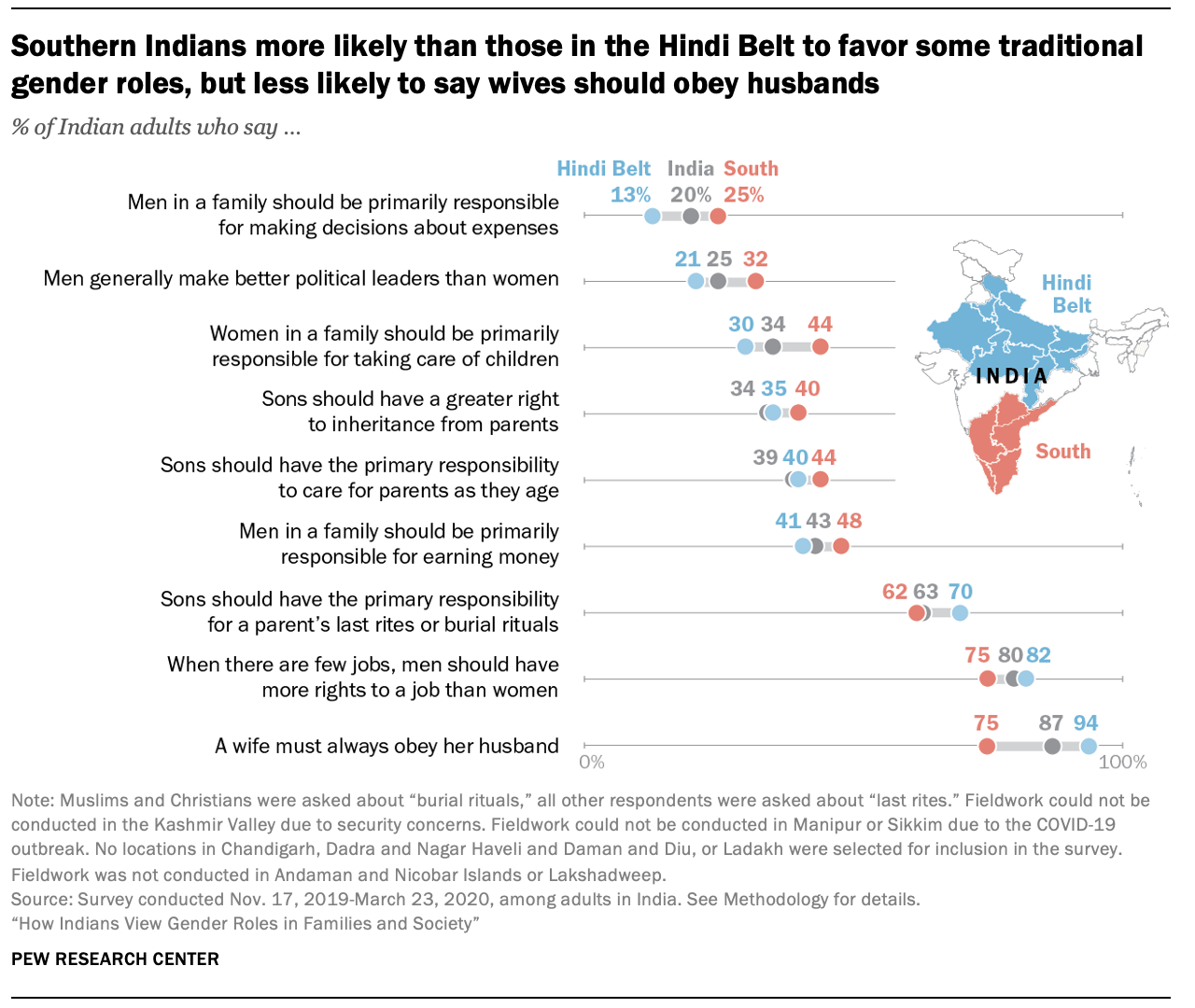
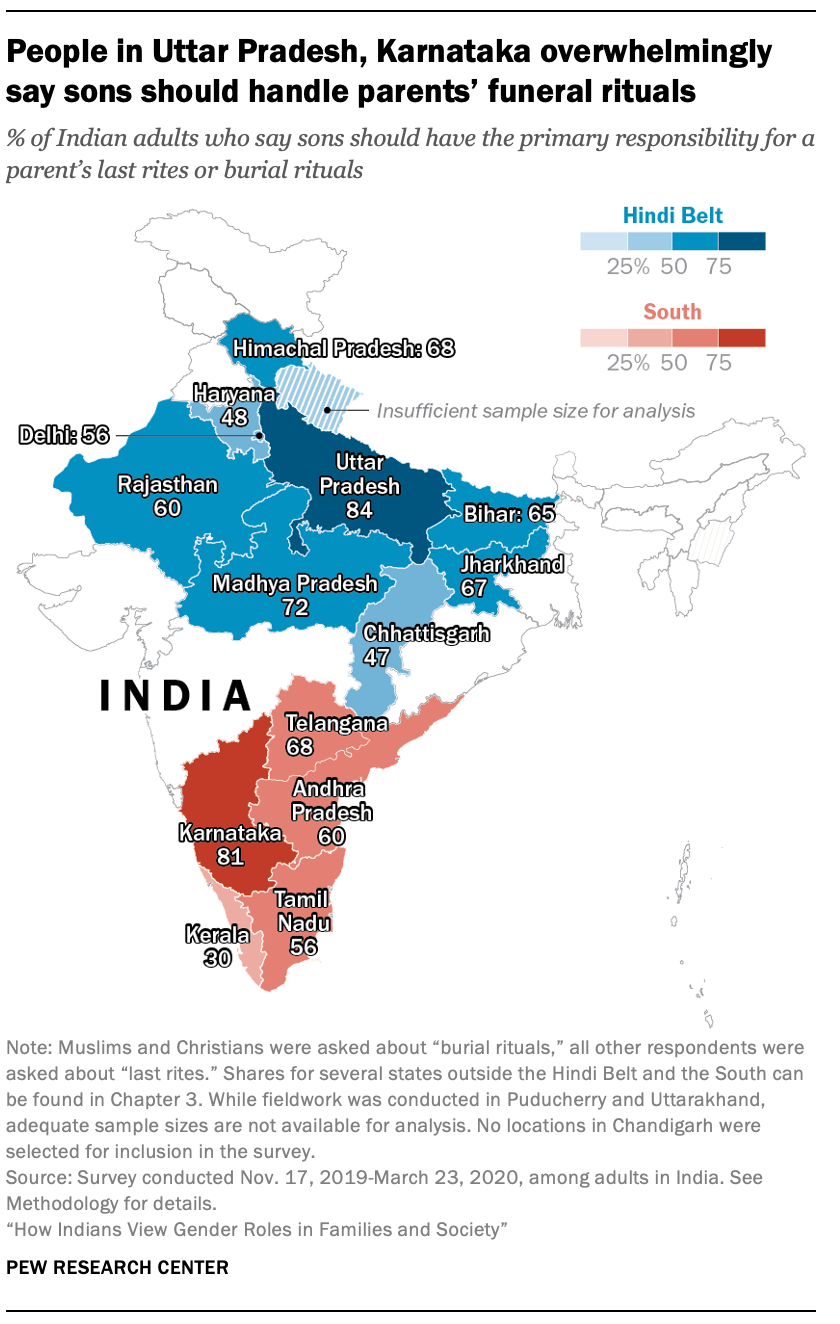 These regional analyses, though, mask significant variation within regions. In the South, people in Karnataka and Andhra Pradesh often express more traditional views than those in Kerala: 81% of Karnataka's residents and 60% in Andhra Pradesh think sons should be responsible for a parent's last rites, while just 30% of Keralites say the same. Meanwhile, attitudes toward gender roles in Tamil Nadu and Telangana tend to vary quite a lot based on the issue; for example, Tamilians are among the least likely to say that a wife must always obey her husband, but the state also has the highest share of people who say women should be primarily responsible for taking care of children.
These regional analyses, though, mask significant variation within regions. In the South, people in Karnataka and Andhra Pradesh often express more traditional views than those in Kerala: 81% of Karnataka's residents and 60% in Andhra Pradesh think sons should be responsible for a parent's last rites, while just 30% of Keralites say the same. Meanwhile, attitudes toward gender roles in Tamil Nadu and Telangana tend to vary quite a lot based on the issue; for example, Tamilians are among the least likely to say that a wife must always obey her husband, but the state also has the highest share of people who say women should be primarily responsible for taking care of children.
The Hindi Belt also has large variations between states on gender roles. For example, Uttar Pradesh is often among the most conservative states, while the National Capital Territory of Delhi is consistently at the other end of spectrum. For complete state-level details on these questions, see Chapter 3.
How regions of India are defined for this report
Previous reporting from this survey largely used membership in India's six zonal councils to define regions. In this report, however, it makes more sense to analyze at the state level due to wide variations among states within the same zone.
This report does, though, describe differences between two commonly discussed regions: the Hindi Belt and the South. While different definitions exist, a broad definition of the Hindi Belt includes the following 11 states and union territories, located in the Northern part of the country: Bihar, Chandigarh, Chhattisgarh, Delhi, Haryana, Himachal Pradesh, Jharkhand, Madhya Pradesh, Rajasthan, Uttar Pradesh and Uttarakhand.
The South includes the following six states and union territories: Andhra Pradesh, Karnataka, Kerala, Puducherry, Tamil Nadu and Telangana.
Sidebar: National Family Health Surveys also show big variation within regions
For example, in the most recently released NFHS data, about a third of men in Southern states (34%) say husbands should have a greater say than wives when making major household purchases, compared with roughly a quarter in Hindi Belt states (27%).8
On this topic, within-region variation is stark in the Hindi Belt. While 37% of residents in Chandigarh think husbands should have more say than wives in major purchases, just 13% in Himachal Pradesh offer this opinion.9 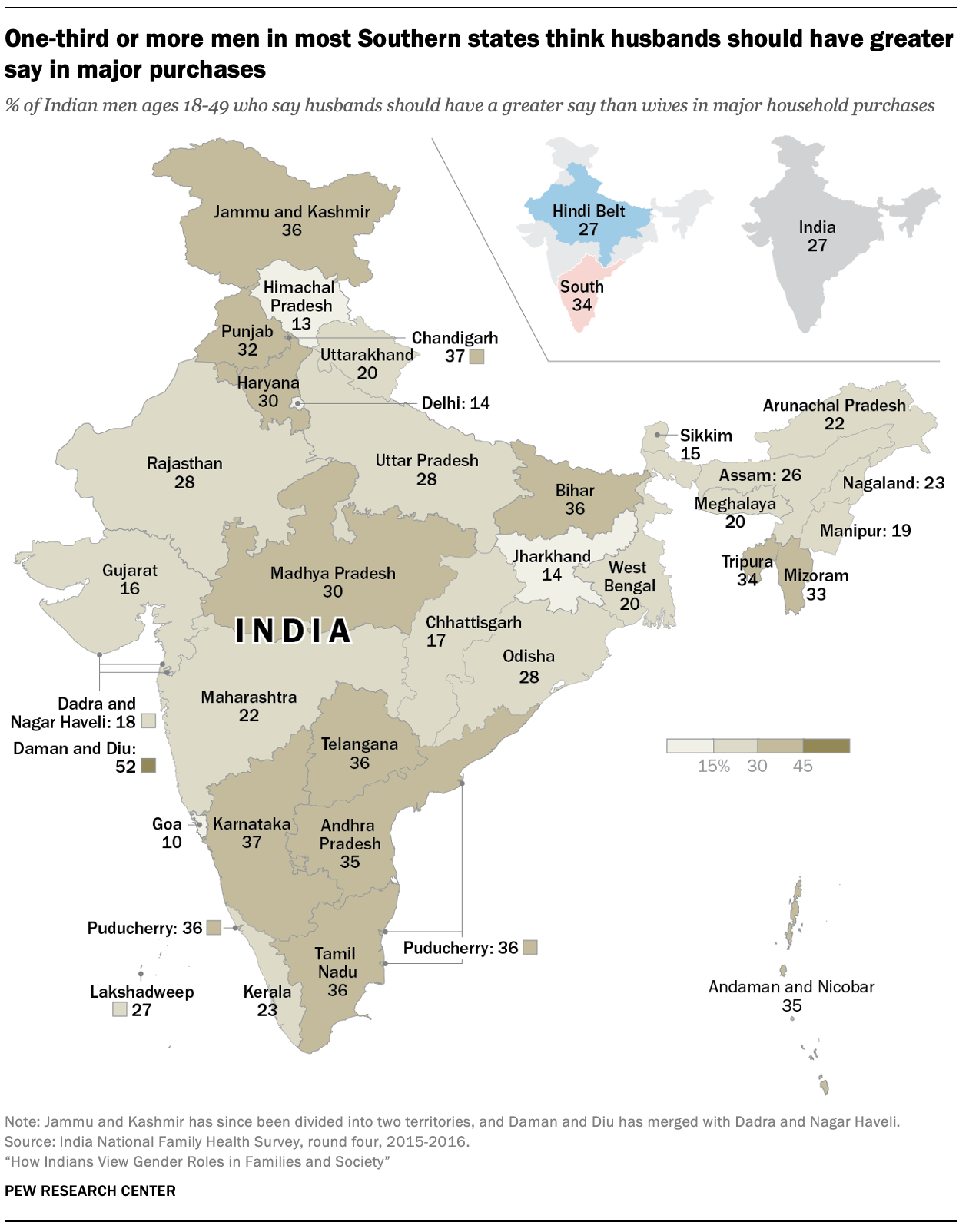
Source: https://www.pewresearch.org/religion/2022/03/02/how-indians-view-gender-roles-in-families-and-society/

0 Response to "Changes and Continuities of Gender Roles in India"
Postar um comentário